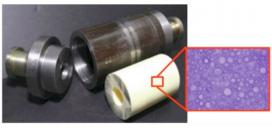Compact Hydraulic In-line Silencer Enabled Using Maintenance-Free Lining
Researchers at the NSF-funded Engineering Research Center (ERC) for Compact and Efficient Fluid Power (CCEFP), headquartered at the University of Minnesota, have developed a novel hydraulic noise control device that employs an engineered compliant material lining.
Excessive noise can increase mechanical fatigue and reduce component life in machinery. Effectively limiting the noise of hydraulic systems is also critical to their use in some applications, such as passenger vehicles.
Currently available noise-control devices are bulky and require more maintenance than is desirable. The hydraulic in-line silencer developed at CCEFP consists of fewer parts than current products while leveraging a maintenance-free lining that ultimately reduces costs for both the manufacturer and the consumer.
Current technology for reducing fluid-borne noise involves both the use of pressurized, gas-filled bladders for adding compliance to fluid power systems, and integrated design features that address such noise sources as cavitation and structural vibration. Pressurized bladders are used in commercially available in-line silencers and in accumulators, which act as low-pass filters. In contrast, the CCEFP researchers envisioned the application of a voided, engineered, compliant lining to noise control devices for fluid power systems.
An early prototype silencer that incorporates a voided polymer lining was developed, which has the same basic effect as a pressurized liner. In experimental tests, the prototype silencer exhibited 25 decibels (dB) of transmission loss from 200-3000 hertz (Hz), and performed comparably to a similarly-sized commercial bladder-style silencer. The current device has been shown to provide up to 30 dB of sound transmission loss.
The material also has uses beyond the silencer and is being considered for compliance control in other applications. The team has constructed other noise control devices that incorporate this lining: a Helmholtz resonator, a tuning coil, and a Quincke tube. The prototype Helmholtz resonator with the voided lining is two orders of magnitude smaller than an unlined resonator of the same resonance frequency.


